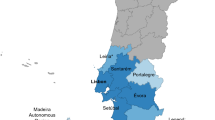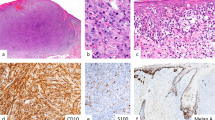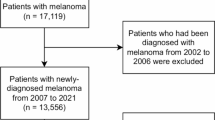Abstract
A case–control study of non-familial melanoma including 183 incident cases and 179 controls was conducted in North-Eastern Italy to identify important risk factors and determine how combination of these affects risk in a Mediterranean population. Presence of dysplastic nevi (OR = 4.2, 95% CI = 2.4–7.4), low propensity to tan (OR = 2.4, 95% CI = 1.1–5.0), light eye (OR = 2.4, 95% CI = 1.1–5.2), and light skin colour (OR = 4.1, 95% CI = 1.4–12.1) were significantly associated with melanoma risk after adjustment for age, gender and pigmentation characteristics. A chart which identifies melanoma risk associated with combinations of these factors is presented; it can be used to identify subjects who would most benefit from preventive measures in Mediterranean populations. According to the combination of these factors, a relative risk range from 1 to 98.5 was found. Light skin colour, high number of sunburns with blistering, and low propensity to tan were significantly associated with melanoma thickness, possibly indicating that individuals with these characteristics underestimate their risk and seek attention when their lesion is already advanced. © 2001 Cancer Research Campaign www.bjcancer.com
Similar content being viewed by others
Article PDF
Change history
16 November 2011
This paper was modified 12 months after initial publication to switch to Creative Commons licence terms, as noted at publication
References
Bliss JM, Ford D, Swerdlow AJ, Armstrong BK, Cristofolini M, Elwood JM, Green A, Holly EA, Mack T and MacKie RM (1995) Risk of cutaneous melanoma associated with pigmentation characteristics and freckling: systematic overview of 10 case-control studies. The International Melanoma Analysis Group (IMAGE). Int J Cancer 62: 367–376
Calista D, Goldstein AM and Landi MT (2000) Melanoma familial aggregation in north-eastern italy. J Invest Dermatol 115: 764–765
Carli P, Biggeri A and Giannotti B (1995) Malignant melanoma in Italy: risks associated with common and clinically atypical melanocytic nevi. J Am Acad Dermatol 32: 734–739
Cristofolini M, Franceschi S, Tasin L, Zumiani G, Piscioli F, Talamini R and La Vecchia C (1987) Risk factors for cutaneous malignant melanoma in a northern Italian population. Int J Cancer 39: 150–154
Elwood JM and Gallagher RP (1999) More about: sunscreen use, wearing clothes, and number of nevi in 6- to 7-year-old European children. J Natl Cancer Inst 91: 1164–1166
Espinosa Arranz J, Sanchez Hernandez JJ, Bravo Fernandez P, Gonzalez-Baron M, Zamora Aunon P, Espinosa Arranz E, Jalon Lopez JI and Ordonez Gallego A (1999) Cutaneous malignant melanoma and sun exposure in Spain. Melanoma Res 9: 199–205
Ferlay J, Bray S, Pisani P and Parkin DM (2001) GLOBOCAN 2000: Cancer incidence, mortality and prevalence worldwide, Version 1.0. CancerBase No. 5. IARCPress: Lyon. Limited version available from: URL: http://www-dep.iarc.fr/globocan/globocan.htm/
Garbe C, Buttner P, Weiss J, Soyer HP, Stocker U, Kruger S, Roser M, Weckbecker J, Panizzon R and Bahmer F (1994) Risk factors for developing cutaneous melanoma and criteria for identifying persons at risk: multicenter case-control study of the Central Malignant Melanoma Registry of the German Dermatological Society. J Invest Dermatol 102: 695–699
Goldstein AM and Tucker MA (1995) Genetic epidemiology of familial melanoma. Dermatol Clin 13: 605–612
Greene MA and Fraumeni JF Jr (1979) The hereditary variant of malignant melanoma. InHuman malignant melanoma, Clark WHJr, Goldman LI, Mastrangelo LJ (eds) pp 139–166. Grune and Stratton: New York
Hartge P, Holly EA, Halpern A, Sagebiel R, Guerry D, Elder D, Clark W, Hanson L, Harrison C and Tarone R (1995) Recognition and classification of clinically dysplastic nevi from photographs: a study of interobserver variation. Cancer Epidemiol Biomarkers Prev 4: 37–40
Jemal A, Devesa SS, Fears TR and Hartge P (2000) Cancer surveillance series: changing patterns of cutaneous malignant melanoma mortality rates among whites in the United States. J Natl Cancer Inst 92: 811–818
La Vecchia C (1999) Sunscreens and the risk of cutaneous malignant melanoma. Eur J Cancer Prev 8: 267–269
Landi MT, Calista D, Landi G, Bernucci I, Bertazzi PA, Clark WHJ, Goldstein AM and Tucker MA (1999) Clinical characteristics of 20 Italian melanoma-prone families. Arch Dermatol 135: 1554–1555
MacKie RM, Freudenberger T and Aitchison TC (1989) Personal risk-factor chart for cutaneous melanoma. Lancet 2: 487–490
Muir CS, Waterhouse J, Mack T, Powell J and Whelan SL (1987) Cancer incidence in five continents. International Agency for Research on Cancer: Lyon
Naldi L, Lorenzo IG, Parazzini F, Gallus S and La Vecchia C (2000a) Pigmentary traits, modalities of sun reaction, history of sunburns, and melanocytic nevi as risk factors for cutaneous malignant melanoma in the Italian population: results of a collaborative case-control study. Cancer 88: 2703–2710
Naldi L, Gallus S, Imberti GL, Cainelli T, Negri E and La Vecchia C (2000b) Sunscreens and cutaneous malignant melanoma: an Italian case-control study. Int J Cancer 86: 879–882
Naldi L, Gallus S, Imberti GL, Cainelli T, Negri E and La Vecchia C (2000c) Sunlamps and sunbeds and the risk of cutaneous melanoma. Italian Group for Epidemiological Research in Dermatology. Eur J Cancer Prev 9: 133–134
Parkin DM, Muir CS, Whelan SL, Gao YT, Ferlay J and Powell J (1992) Cancer incidence in five continents. International Agency for Research on Cancer: Lyon
Rodenas JM, Delgado-Rodriguez M, Herranz MT, Tercedor J and Serrano S (1996) Sun exposure, pigmentary traits, and risk of cutaneous malignant melanoma: a case-control study in a Mediterranean population. Cancer Causes Control 7: 275–283
Rosso S, Zanetti R, Pippione M and Sancho-Garnier H (1998) Parallel risk assessment of melanoma and basal cell carcinoma: skin characteristics and sun exposure. Melanoma Res 8: 573–583
Scotto J, Fears TR and Fraumeni JF Jr (1996) Solar radiation. InCancer epidemiology and prevention, Schottenfeld D, Fraumeni JF Jr. (eds) pp 355–372, Oxford University Press: New York
Tucker MA, Halpern A, Holly EA, Hartge P, Elder DE, Sagebiel RW, Guerry D and Clark WHJ (1997) Clinically recognized dysplastic nevi. A central risk factor for cutaneous melanoma. JAMA 277: 1439–1444
Vinceti M, Bergomi M, Borciani N, Serra L and Vivoli G (1999) Rising melanoma incidence in an Italian community from 1986 to 1997. Melanoma Res 9: 97–103
Zanetti R, Rosso S, Colonna S, Martina G and Paudice A (1988) Studio caso-controllo sul melanoma maligno cutaneo in provincia di Torino [Case-control study on malignant skin melanoma in the Turin province]. G Ital Dermatol Venereol 123: 461–468
Zanetti R, Gafa L, Franceschi S, Pippione M and Rosso S (1999) Estimate of the proportion of skin tumors attributable to sun exposure in 3 Italian populations. Epidemiol Prev 23: 416–422
Author information
Authors and Affiliations
Rights and permissions
From twelve months after its original publication, this work is licensed under the Creative Commons Attribution-NonCommercial-Share Alike 3.0 Unported License. To view a copy of this license, visit http://creativecommons.org/licenses/by-nc-sa/3.0/
About this article
Cite this article
Landi, M., Baccarelli, A., Calista, D. et al. Combined risk factors for melanoma in a Mediterranean population. Br J Cancer 85, 1304–1310 (2001). https://doi.org/10.1054/bjoc.2001.2029
Received:
Revised:
Accepted:
Published:
Issue date:
DOI: https://doi.org/10.1054/bjoc.2001.2029
Keywords
This article is cited by
-
Independent Validation of Six Melanoma Risk Prediction Models
Journal of Investigative Dermatology (2015)
-
Association of Genetic Variants in CDK6 and XRCC1 with the Risk of Dysplastic Nevi in Melanoma-Prone Families
Journal of Investigative Dermatology (2014)
-
MC1R Variants Increase Risk of Melanomas Harboring BRAF Mutations
Journal of Investigative Dermatology (2008)
-
Risk associations of melanoma in a Southern European population: results of a case/control study
Cancer Causes & Control (2008)
-
Melanocortin Receptor-1 Gene Polymorphisms and the Risk of Cutaneous Melanoma in a Low-Risk Southern European Population
Journal of Investigative Dermatology (2006)



